fuel SKODA FABIA 2008 2.G / 5J User Guide
[x] Cancel search | Manufacturer: SKODA, Model Year: 2008, Model line: FABIA, Model: SKODA FABIA 2008 2.G / 5JPages: 252, PDF Size: 40.88 MB
Page 20 of 252
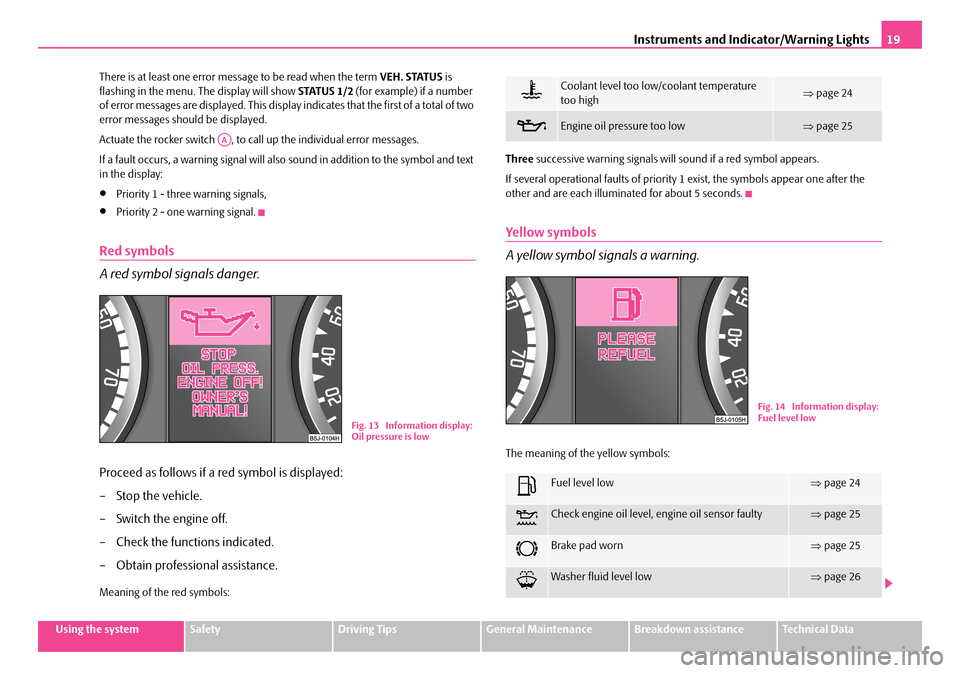
Instruments and Indicator/Warning Lights19
Using the systemSafetyDriving TipsGeneral MaintenanceBreakdown assistanceTechnical Data
There is at least one error message to be read when the term VEH. STATUS is flashing in the menu. The display will show STATUS 1/2 (for example) if a number of error messages are displayed. This display indicates that the first of a total of two error messages should be displayed.
Actuate the rocker switch , to call up the individual error messages.
If a fault occurs, a warning signal will also sound in addition to the symbol and text in the display:
•Priority 1 - three warning signals,
•Priority 2 - one warning signal.
Red symbols
A red symbol signals danger.
Proceed as follows if a red symbol is displayed:
– Stop the vehicle.
– Switch the engine off.
– Check the functions indicated.
– Obtain professional assistance.
Meaning of the red symbols:
Three successive warning signals will sound if a red symbol appears.
If several operational faults of priority 1 exist, the symbols appear one after the other and are each illuminated for about 5 seconds.
Yellow symbols
A yellow symbol signals a warning.
The meaning of the yellow symbols:
AA
Fig. 13 Information display: Oil pressure is low
Coolant level too low/coolant temperature too high⇒page 24
Engine oil pressure too low ⇒page 25
Fuel level low⇒page 24
Check engine oil level, engine oil sensor faulty⇒page 25
Brake pad worn⇒page 25
Washer fluid level low⇒page 26
Fig. 14 Information display: Fuel level low
NKO A05F 20.book Page 19 Wednesday, April 2, 2008 1:02 PM
Page 22 of 252
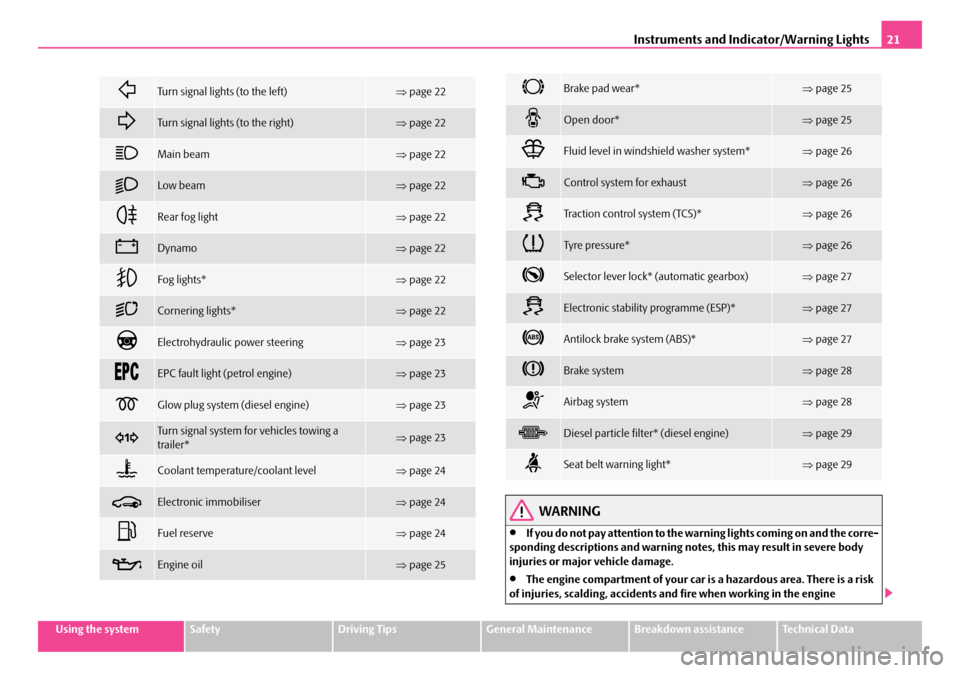
Instruments and Indicator/Warning Lights21
Using the systemSafetyDriving TipsGeneral MaintenanceBreakdown assistanceTechnical Data
WARNING
•If you do not pay attention to the warning lights coming on and the corre-sponding descriptions and warning notes, this may result in severe body injuries or major vehicle damage.
•The engine compartment of your car is a hazardous area. There is a risk of injuries, scalding, accidents and fire when working in the engine
Turn signal lights (to the left)⇒page 22
Turn signal lights (to the right)⇒page 22
Main beam⇒page 22
Low beam⇒page 22
Rear fog light⇒page 22
Dynamo⇒page 22
Fog lights*⇒page 22
Cornering lights*⇒page 22
Electrohydraulic power steering⇒page 23
EPC fault light (petrol engine)⇒page 23
Glow plug system (diesel engine)⇒page 23
Turn signal system for vehicles towing a trailer*⇒page 23
Coolant temperature/coolant level⇒page 24
Electronic immobiliser⇒page 24
Fuel reserve⇒page 24
Engine oil⇒page 25
Brake pad wear*⇒page 25
Open door*⇒page 25
Fluid level in windshield washer system*⇒page 26
Control system for exhaust⇒page 26
Traction control system (TCS)*⇒page 26
Tyre pres su re*⇒page 26
Selector lever lock* (automatic gearbox)⇒page 27
Electronic stability programme (ESP)*⇒page 27
Antilock brake system (ABS)*⇒page 27
Brake system⇒page 28
Airbag system⇒page 28
Diesel particle filter* (diesel engine)⇒page 29
Seat belt warning light*⇒page 29
NKO A05F 20.book Page 21 Wednesday, April 2, 2008 1:02 PM
Page 25 of 252
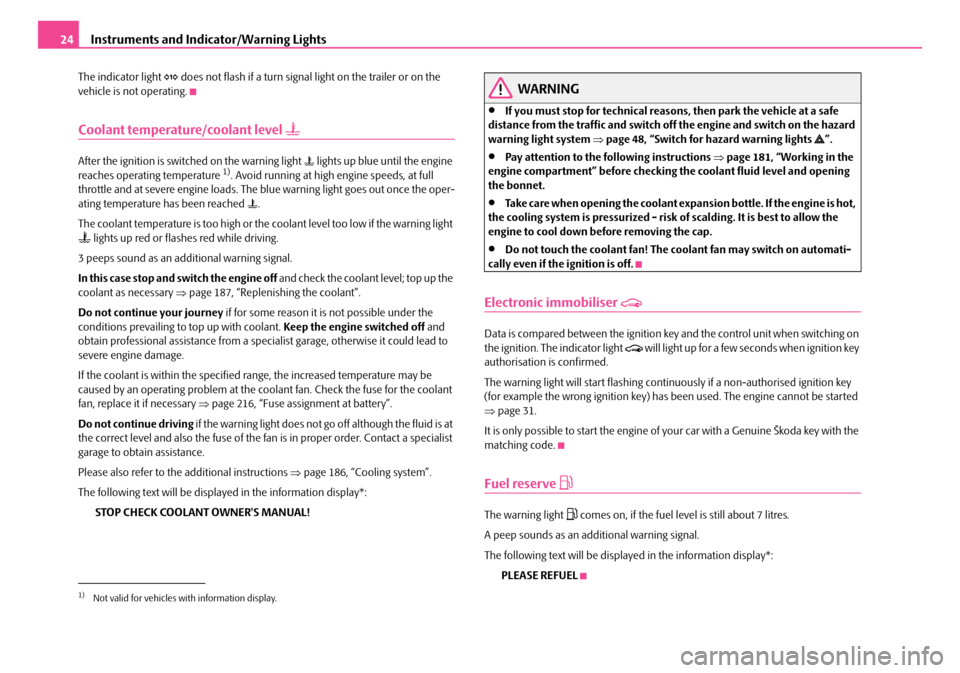
Instruments and Indicator/Warning Lights24
The indicator light does not flash if a turn signal light on the trailer or on the vehicle is not operating.
Coolant temperature/coolant level
After the ignition is switched on the warning light lights up blue until the engine reaches operating temperature 1). Avoid running at high engine speeds, at full throttle and at severe engine loads. The blue warning light goes out once the oper-ating temperature has been reached .
The coolant temperature is too high or the coolant level too low if the warning light lights up red or flashes red while driving.
3 peeps sound as an additional warning signal.
In this case stop and switch the engine off and check the coolant level; top up the coolant as necessary ⇒page 187, “Replenishing the coolant”.
Do not continue your journey if for some reason it is not possible under the conditions prevailing to top up with coolant. Keep the engine switched off and obtain professional assistance from a specialist garage, otherwise it could lead to severe engine damage.
If the coolant is within the specified range, the increased temperature may be caused by an operating problem at the coolant fan. Check the fuse for the coolant fan, replace it if necessary ⇒page 216, “Fuse assignment at battery”.
Do not continue driving if the warning light does not go off although the fluid is at the correct level and also the fuse of the fan is in proper order. Contact a specialist garage to obtain assistance.
Please also refer to the additional instructions ⇒page 186, “Cooling system”.
The following text will be displayed in the information display*:
STOP CHECK COOLANT OWNER'S MANUAL!
WARNING
•If you must stop for technical reasons, then park the vehicle at a safe distance from the traffic and switch off the engine and switch on the hazard warning light system ⇒page 48, “Switch for hazard warning lights ”.
•Pay attention to the following instructions ⇒page 181, “Working in the engine compartment” before checking the coolant fluid level and opening the bonnet.
•Take care when opening the coolant expansion bottle. If the engine is hot, the cooling system is pressurized - risk of scalding. It is best to allow the engine to cool down before removing the cap.
•Do not touch the coolant fan! The coolant fan may switch on automati-cally even if the ignition is off.
Electronic immobiliser
Data is compared between the ignition key and the control unit when switching on the ignition. The indicator light will light up for a few seconds when ignition key authorisation is confirmed.
The warning light will start flashing continuously if a non-authorised ignition key (for example the wrong ignition key) has been used. The engine cannot be started ⇒page 31.
It is only possible to start the engine of your car with a Genuine Škoda key with the matching code.
Fuel reserve
The warning light comes on, if the fuel level is still about 7 litres.
A peep sounds as an additional warning signal.
The following text will be displayed in the information display*:
PLEASE REFUEL
1)Not valid for vehicles with information display.
NKO A05F 20.book Page 24 Wednesday, April 2, 2008 1:02 PM
Page 30 of 252
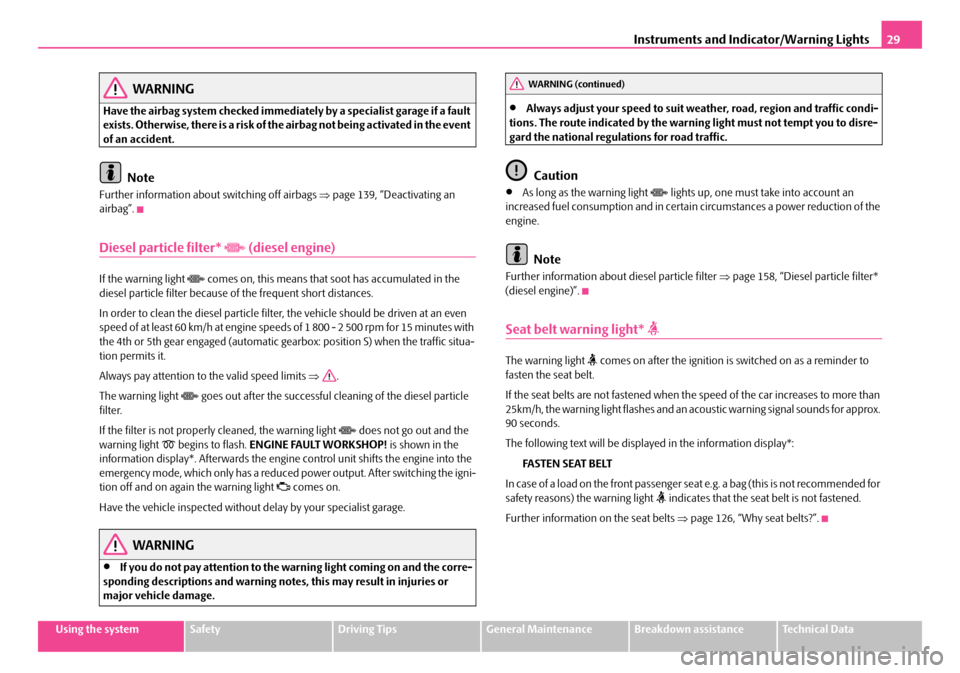
Instruments and Indicator/Warning Lights29
Using the systemSafetyDriving TipsGeneral MaintenanceBreakdown assistanceTechnical Data
WARNING
Have the airbag system checked immediately by a specialist garage if a fault exists. Otherwise, there is a risk of the airbag not being activated in the event of an accident.
Note
Further information about switching off airbags ⇒page 139, “Deactivating an airbag”.
Diesel particle filter* (diesel engine)
If the warning light comes on, this means that soot has accumulated in the diesel particle filter because of the frequent short distances.
In order to clean the diesel particle filter, the vehicle should be driven at an even speed of at least 60 km/h at engine speeds of 1 800 - 2 500 rpm for 15 minutes with the 4th or 5th gear engaged (automatic gearbox: position S) when the traffic situa-tion permits it.
Always pay attention to the valid speed limits ⇒.
The warning light goes out after the successful cleaning of the diesel particle filter.
If the filter is not properly cleaned, the warning light does not go out and the warning light begins to flash. ENGINE FAULT WORKSHOP! is shown in the information display*. Afterwards the engine control unit shifts the engine into the emergency mode, which only has a reduced power output. After switching the igni-tion off and on again the warning light comes on.
Have the vehicle inspected without delay by your specialist garage.
WARNING
•If you do not pay attention to the warning light coming on and the corre-sponding descriptions and warning notes, this may result in injuries or major vehicle damage.
•Always adjust your speed to suit weather, road, region and traffic condi-tions. The route indicated by the warning light must not tempt you to disre-gard the national regulations for road traffic.
Caution
•As long as the warning light lights up, one must take into account an increased fuel consumption and in certain circumstances a power reduction of the engine.
Note
Further information about diesel particle filter ⇒page 158, “Diesel particle filter* (diesel engine)”.
Seat belt warning light*
The warning light comes on after the ignition is switched on as a reminder to fasten the seat belt.
If the seat belts are not fastened when the speed of the car increases to more than 25km/h, the warning light flashes and an acoustic warning signal sounds for approx. 90 seconds.
The following text will be displayed in the information display*:
FASTEN SEAT BELT
In case of a load on the front passenger seat e.g. a bag (this is not recommended for safety reasons) the warning light indicates that the seat belt is not fastened.
Further information on the seat belts ⇒page 126, “Why seat belts?”.
WARNING (continued)
NKO A05F 20.book Page 29 Wednesday, April 2, 2008 1:02 PM
Page 52 of 252
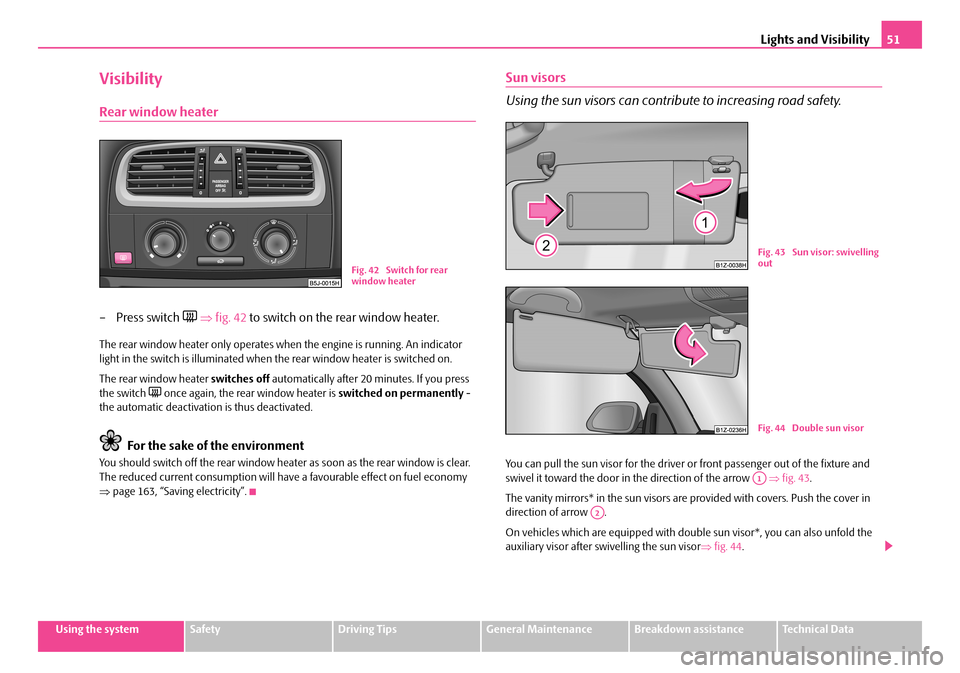
Lights and Visibility51
Using the systemSafetyDriving TipsGeneral MaintenanceBreakdown assistanceTechnical Data
Visibility
Rear window heater
– Press switch ⇒fig. 42 to switch on the rear window heater.
The rear window heater only operates when the engine is running. An indicator light in the switch is illuminated when the rear window heater is switched on.
The rear window heater switches off automatically after 20 minutes. If you press the switch once again, the rear window heater is switched on permanently - the automatic deactivation is thus deactivated.
For the sake of the environment
You should switch off the rear window heater as soon as the rear window is clear. The reduced current consumption will have a favourable effect on fuel economy ⇒page 163, “Saving electricity”.
Sun visors
Using the sun visors can contribute to increasing road safety.
You can pull the sun visor for the driver or front passenger out of the fixture and swivel it toward the door in the direction of the arrow ⇒fig. 43.
The vanity mirrors* in the sun visors are provided with covers. Push the cover in direction of arrow .
On vehicles which are equipped with double sun visor*, you can also unfold the auxiliary visor after swivelling the sun visor⇒fig. 44.
Fig. 42 Switch for rear window heater
Fig. 43 Sun visor: swivelling out
Fig. 44 Double sun visor
A1
A2
NKO A05F 20.book Page 51 Wednesday, April 2, 2008 1:02 PM
Page 54 of 252

Lights and Visibility53
Using the systemSafetyDriving TipsGeneral MaintenanceBreakdown assistanceTechnical Data
The windscreen wipers and the windscreen washer system only operate if the igni-tion is switched on.
The rear window will be wiped again if the front window wipers are on when reverse gear is selected.
The windscreen washer nozzles are heated* when the ignition is switched on.
Top up with wash liquid ⇒page 193.
WARNING
•Properly maintained windscreen wiper blades are essential for clear visi-bility and safe driving ⇒page 53.
•Do not use the windscreen washer system at low temperatures, without heating the windscreen beforehand. Otherwise the window cleaner could freeze on the windscreen and restrict the view to the front.
•In the event of a freezing up of the windscreen, first of all eliminate the ice ⇒page 172 and then operate the windscreen wiper otherwise the wind-screen wiper blades could be damaged.
Caution
In frosty weather, please first of all check whether the windscreen wiper blades are not frozen to the windscreen before switching them on. Switching on windscreen wipers when the blades are frozen to the windscreen may result in damage both to the blades and the motor of the windscreen wipers!
Headlight cleaning system*
The headlights are being cleaned after the windscreen washer system has been operated for the fifth time, the low beam or main beam are switched on as well as the windscreen wiper lever is held in the position ⇒page 52, fig. 45 for about 1 second.
You should remove stubborn dirt (such as insect residues) from the headlight lenses at regular intervals, for example when refuelling. Please refer to the following guidelines ⇒page 172, “The headlight lenses”.
You should remove any snow from the fixtures of the washer nozzles and clear ice in winter with a de-icing spray in order to ensure proper operation of the cleaning system.
Replacing wiper blades for the windscreen wipers
Taking off the wiper blade
– Fold windscreen wiper arm away from the windscreen.
– Press the locking button, in order to unlock the wiper blade and pull
off in the direction of arrow.
Attaching a wiper blade
– Push the wiper blade until it locks up to the stop.
– Check whether the wiper blade is correctly attached.
– Fold the windscreen wiper arm back onto the windscreen.
Wiper blades in proper condition are essential to obtain good visibility. Wiper blades should not be allowed to become dirtied by dust, insect remains and preserving wax.
Juddering or smearing of the wiper blades could then be due to wax residues left on the windscreen by vehicle washing in automatic vehicle wash systems. It is
A5
Fig. 46 Wiper blade for the windscreen wiper
NKO A05F 20.book Page 53 Wednesday, April 2, 2008 1:02 PM
Page 74 of 252
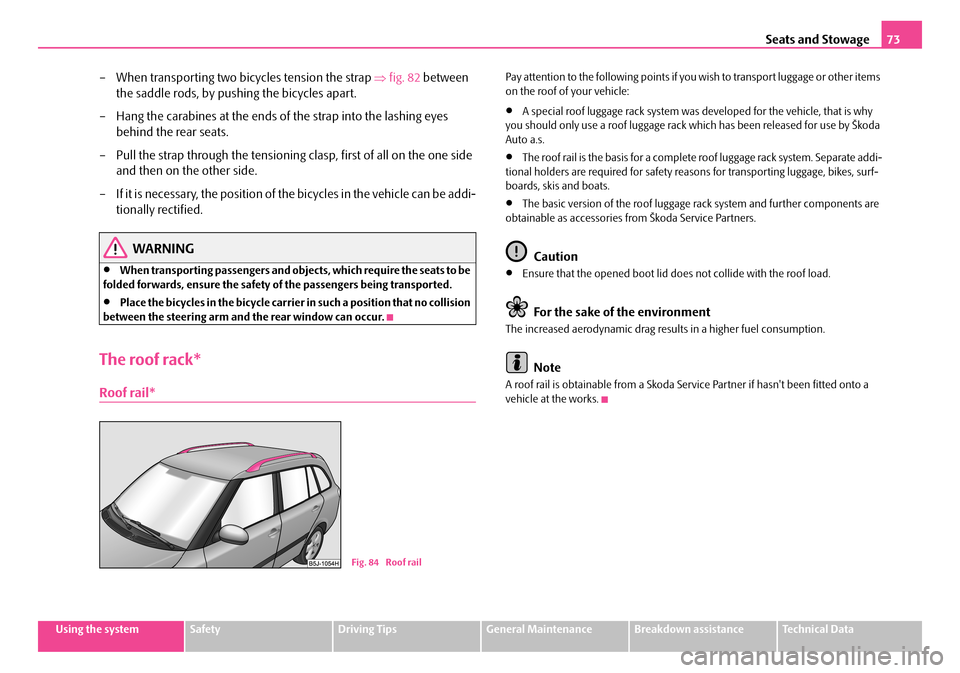
Seats and Stowage73
Using the systemSafetyDriving TipsGeneral MaintenanceBreakdown assistanceTechnical Data
– When transporting two bicycles tension the strap ⇒fig. 82 between
the saddle rods, by pushing the bicycles apart.
– Hang the carabines at the ends of the strap into the lashing eyes
behind the rear seats.
– Pull the strap through the tensioning clasp, first of all on the one side
and then on the other side.
– If it is necessary, the position of the bicycles in the vehicle can be addi-
tionally rectified.
WARNING
•When transporting passengers and objects, which require the seats to be folded forwards, ensure the safety of the passengers being transported.
•Place the bicycles in the bicycle carrier in such a position that no collision between the steering arm and the rear window can occur.
The roof rack*
Roof rail*
Pay attention to the following points if you wish to transport luggage or other items on the roof of your vehicle:
•A special roof luggage rack system was developed for the vehicle, that is why you should only use a roof luggage rack which has been released for use by Škoda Auto a.s.
•The roof rail is the basis for a complete roof luggage rack system. Separate addi-tional holders are required for safety reasons for transporting luggage, bikes, surf-boards, skis and boats.
•The basic version of the roof luggage rack system and further components are obtainable as accessories from Škoda Service Partners.
Caution
•Ensure that the opened boot lid does not collide with the roof load.
For the sake of the environment
The increased aerodynamic drag results in a higher fuel consumption.
Note
A roof rail is obtainable from a Skoda Service Partner if hasn't been fitted onto a vehicle at the works.
Fig. 84 Roof rail
NKO A05F 20.book Page 73 Wednesday, April 2, 2008 1:02 PM
Page 90 of 252
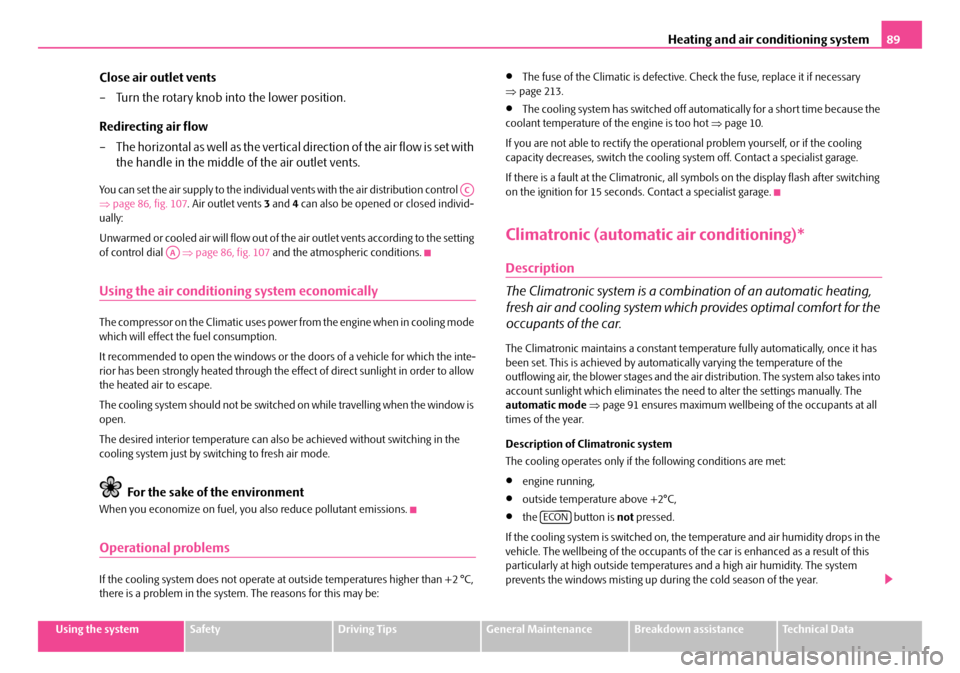
Heating and air conditioning system89
Using the systemSafetyDriving TipsGeneral MaintenanceBreakdown assistanceTechnical Data
Close air outlet vents
– Turn the rotary knob into the lower position.
Redirecting air flow
– The horizontal as well as the vertical direction of the air flow is set with
the handle in the middle of the air outlet vents.
You can set the air supply to the individual vents with the air distribution control ⇒page 86, fig. 107. Air outlet vents 3 and 4 can also be opened or closed individ-ually:
Unwarmed or cooled air will flow out of the air outlet vents according to the setting of control dial ⇒page 86, fig. 107 and the atmospheric conditions.
Using the air conditioning system economically
The compressor on the Climatic uses power from the engine when in cooling mode which will effect the fuel consumption.
It recommended to open the windows or the doors of a vehicle for which the inte-rior has been strongly heated through the effect of direct sunlight in order to allow the heated air to escape.
The cooling system should not be switched on while travelling when the window is open.
The desired interior temperature can also be achieved without switching in the cooling system just by switching to fresh air mode.
For the sake of the environment
When you economize on fuel, you also reduce pollutant emissions.
Operational problems
If the cooling system does not operate at outside temperatures higher than +2 °C, there is a problem in the system. The reasons for this may be:
•The fuse of the Climatic is defective. Check the fuse, replace it if necessary ⇒page 213.
•The cooling system has switched off automatically for a short time because the coolant temperature of the engine is too hot ⇒page 10.
If you are not able to rectify the operational problem yourself, or if the cooling capacity decreases, switch the cooling system off. Contact a specialist garage.
If there is a fault at the Climatronic, all symbols on the display flash after switching on the ignition for 15 seconds. Contact a specialist garage.
Climatronic (automatic air conditioning)*
Description
The Climatronic system is a combination of an automatic heating,
fresh air and cooling system which provides optimal comfort for the
occupants of the car.
The Climatronic maintains a constant temperature fully automatically, once it has been set. This is achieved by automatically varying the temperature of the outflowing air, the blower stages and the air distribution. The system also takes into account sunlight which eliminates the need to alter the settings manually. The automatic mode ⇒page 91 ensures maximum wellbeing of the occupants at all times of the year.
Description of Climatronic system
The cooling operates only if the following conditions are met:
•engine running,
•outside temperature above +2°C,
•the button is not pressed.
If the cooling system is switched on, the temperature and air humidity drops in the vehicle. The wellbeing of the occupants of the car is enhanced as a result of this particularly at high outside temperatures and a high air humidity. The system prevents the windows misting up during the cold season of the year.
AC
AA
ECON
NKO A05F 20.book Page 89 Wednesday, April 2, 2008 1:02 PM
Page 96 of 252
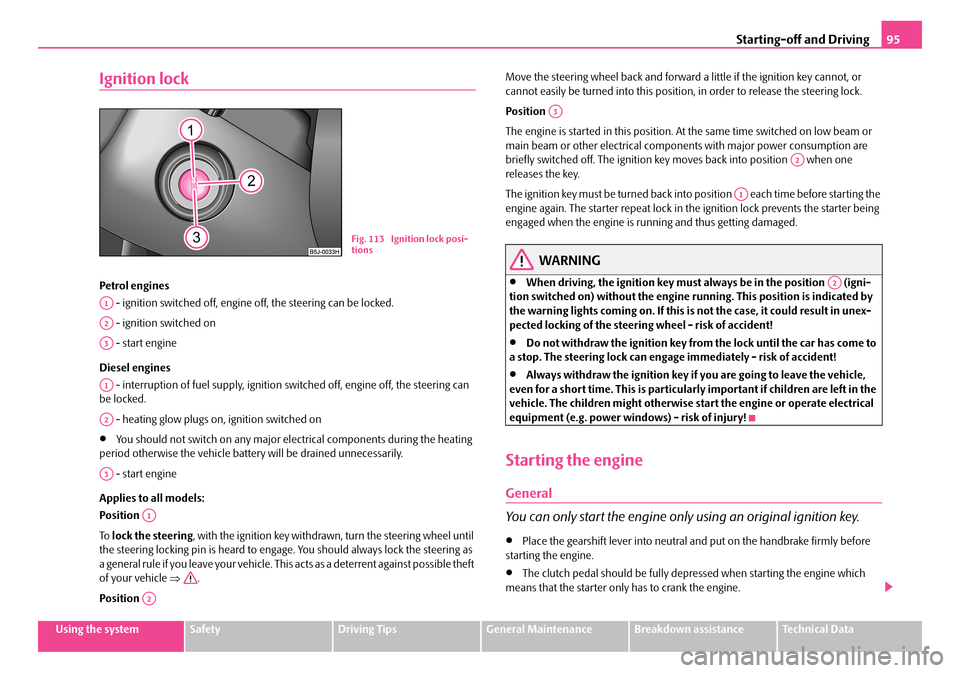
Starting-off and Driving95
Using the systemSafetyDriving TipsGeneral MaintenanceBreakdown assistanceTechnical Data
Ignition lock
Petrol engines
- ignition switched off, engine off, the steering can be locked.
- ignition switched on
- start engine
Diesel engines
- interruption of fuel supply, ignition switched off, engine off, the steering can be locked.
- heating glow plugs on, ignition switched on
•You should not switch on any major electrical components during the heating period otherwise the vehicle battery will be drained unnecessarily.
- start engine
Applies to all models:
Position
To lock the steering, with the ignition key withdrawn, turn the steering wheel until the steering locking pin is heard to engage. You should always lock the steering as a general rule if you leave your vehicle. This acts as a deterrent against possible theft of your vehicle ⇒.
Position
Move the steering wheel back and forward a little if the ignition key cannot, or cannot easily be turned into this position, in order to release the steering lock.
Position
The engine is started in this position. At the same time switched on low beam or main beam or other electrical components with major power consumption are briefly switched off. The ignition key moves back into position when one releases the key.
The ignition key must be turned back into position each time before starting the engine again. The starter repeat lock in the ignition lock prevents the starter being engaged when the engine is running and thus getting damaged.
WARNING
•When driving, the ignition key must always be in the position (igni-tion switched on) without the engine running. This position is indicated by the warning lights coming on. If this is not the case, it could result in unex-pected locking of the steering wheel - risk of accident!
•Do not withdraw the ignition key from the lock until the car has come to a stop. The steering lock can engage immediately - risk of accident!
•Always withdraw the ignition key if you are going to leave the vehicle, even for a short time. This is particularly important if children are left in the vehicle. The children might otherwise start the engine or operate electrical equipment (e.g. power windows) - risk of injury!
Starting the engine
General
You can only start the engine only using an original ignition key.
•Place the gearshift lever into neutral and put on the handbrake firmly before starting the engine.
•The clutch pedal should be fully depressed when starting the engine which means that the starter only has to crank the engine.
Fig. 113 Ignition lock posi-tions
A1
A2
A3
A1
A2
A3
A1
A2
A3
A2
A1
A2
NKO A05F 20.book Page 95 Wednesday, April 2, 2008 1:02 PM
Page 97 of 252
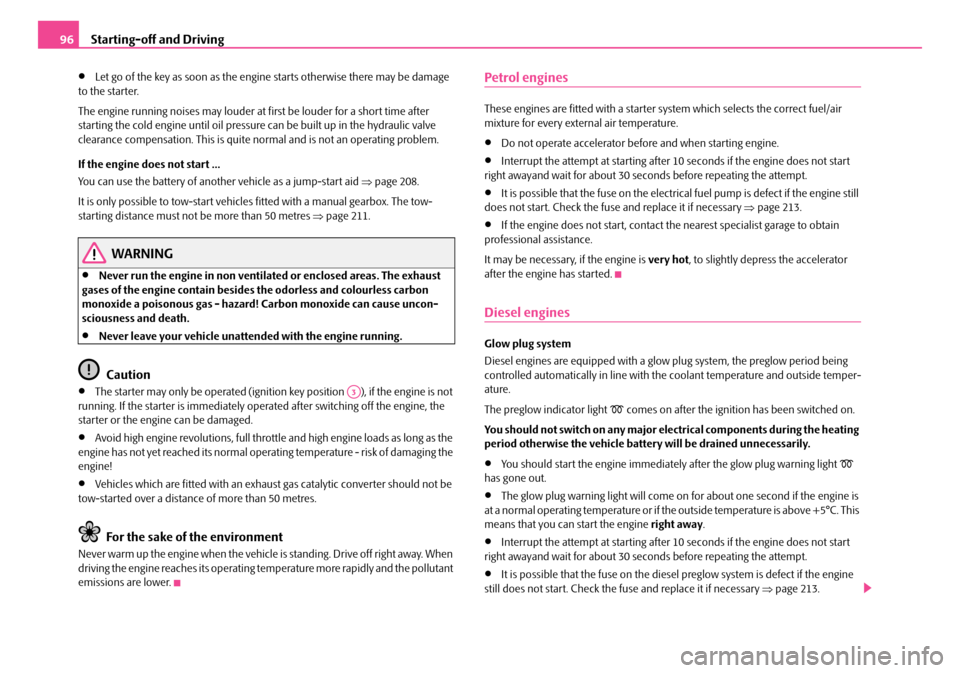
Starting-off and Driving96
•Let go of the key as soon as the engine starts otherwise there may be damage to the starter.
The engine running noises may louder at first be louder for a short time after starting the cold engine until oil pressure can be built up in the hydraulic valve clearance compensation. This is quite normal and is not an operating problem.
If the engine does not start ...
You can use the battery of another vehicle as a jump-start aid ⇒page 208.
It is only possible to tow-start vehicles fitted with a manual gearbox. The tow-starting distance must not be more than 50 metres ⇒page 211.
WARNING
•Never run the engine in non ventilated or enclosed areas. The exhaust gases of the engine contain besides the odorless and colourless carbon monoxide a poisonous gas - hazard! Carbon monoxide can cause uncon-sciousness and death.
•Never leave your vehicle unattended with the engine running.
Caution
•The starter may only be operated (ignition key position ), if the engine is not running. If the starter is immediately operated after switching off the engine, the starter or the engine can be damaged.
•Avoid high engine revolutions, full throttle and high engine loads as long as the engine has not yet reached its normal operating temperature - risk of damaging the engine!
•Vehicles which are fitted with an exhaust gas catalytic converter should not be tow-started over a distance of more than 50 metres.
For the sake of the environment
Never warm up the engine when the vehicle is standing. Drive off right away. When driving the engine reaches its operating temperature more rapidly and the pollutant emissions are lower.
Petrol engines
These engines are fitted with a starter system which selects the correct fuel/air mixture for every external air temperature.
•Do not operate accelerator before and when starting engine.
•Interrupt the attempt at starting after 10 seconds if the engine does not start right awayand wait for about 30 seconds before repeating the attempt.
•It is possible that the fuse on the electrical fuel pump is defect if the engine still does not start. Check the fuse and replace it if necessary ⇒page 213.
•If the engine does not start, contact the nearest specialist garage to obtain professional assistance.
It may be necessary, if the engine is very hot, to slightly depress the accelerator after the engine has started.
Diesel engines
Glow plug system
Diesel engines are equipped with a glow plug system, the preglow period being controlled automatically in line with the coolant temperature and outside temper-ature.
The preglow indicator light comes on after the ignition has been switched on.
You should not switch on any major electrical components during the heating period otherwise the vehicle battery will be drained unnecessarily.
•You should start the engine immediately after the glow plug warning light has gone out.
•The glow plug warning light will come on for about one second if the engine is at a normal operating temperature or if the outside temperature is above +5°C. This means that you can start the engine right away.
•Interrupt the attempt at starting after 10 seconds if the engine does not start right awayand wait for about 30 seconds before repeating the attempt.
•It is possible that the fuse on the diesel preglow system is defect if the engine still does not start. Check the fuse and replace it if necessary ⇒page 213.
A3
NKO A05F 20.book Page 96 Wednesday, April 2, 2008 1:02 PM